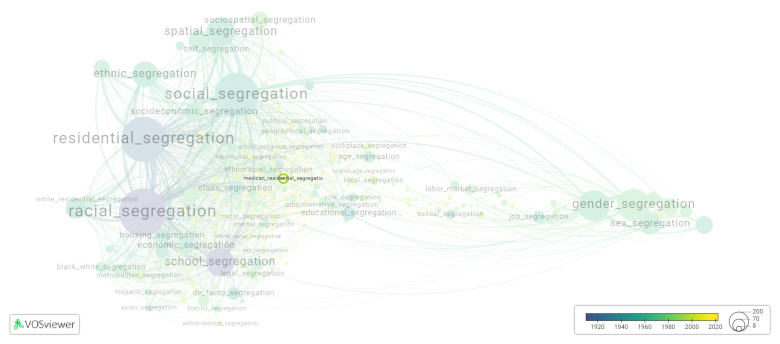Mexican residential segregation: Difference between revisions
(Creating page) |
(Creating page) |
||
| (One intermediate revision by the same user not shown) | |||
| Line 20: | Line 20: | ||
[[File:mexican_residential_segregation.png|780x780px]] | [[File:mexican_residential_segregation.png|780x780px]] | ||
This visualization is based on the study [[Segregation_Wiki:About| The Multidisciplinary Landscape of Segregation Research]]. | |||
For the complete network of | For the complete network of interrelated segregation forms, please refer to: | ||
* | * [https://tinyurl.com/2235lkhw First year of publication] | ||
* | * [https://tinyurl.com/2d8wg5n3 Louvain clusters] | ||
* | * [https://tinyurl.com/223udk5r Betweenness centrality] | ||
* | * [https://tinyurl.com/244d8unz Disciplines in which segregation forms first emerged (Scopus database).] | ||
==References== | ==References== | ||
==Notes== | ==Notes== | ||
Latest revision as of 07:17, 16 October 2024
Date and country of first publication[1][edit | edit source]
2006
United States
Definition[edit | edit source]
Mexican residential segregation refers to the phenomenon of Mexicans living in separate neighborhoods or communities, often characterized by a high concentration of Mexican residents. This segregation is based on various social and economic factors, including historical discrimination, social exclusion, poverty, and immigration patterns.
In some cases, Mexicans may choose to live in ethnic enclaves as a way to preserve their cultural identity and maintain close ties with their community. These enclaves are often characterized by shared language, customs, and traditions. They may offer a sense of belonging and provide a support network for immigrants and their families.
However, residential segregation can also be a result of systemic inequalities and discriminatory practices. Historically, Mexicans in the United States have faced discrimination and unequal access to housing, education, and employment opportunities. These factors have contributed to the clustering of Mexicans in certain neighborhoods where they may face limited opportunities for social and economic mobility.
Mexican residential segregation can have both positive and negative effects. On one hand, it can foster a strong sense of community and provide cultural support systems. On the other hand, it can contribute to social and economic inequalities, as segregated neighborhoods often lack resources and face issues such as underfunded schools, limited access to healthcare, and higher crime rates.
Efforts to address Mexican residential segregation often involve advocating for fair housing policies, equal access to education and employment opportunities, and promoting diverse and inclusive communities. Additionally, creating opportunities for dialogue and cultural exchange between different neighborhoods and communities can help foster understanding and break down barriers that contribute to residential segregation.
See also[edit | edit source]
Related segregation forms[edit | edit source]
Mexican residential segregation is frequently discussed in the literature with the following segregation forms:
residential segregation, self segregation, latino segregation, puerto rican segregation

This visualization is based on the study The Multidisciplinary Landscape of Segregation Research.
For the complete network of interrelated segregation forms, please refer to:
References[edit | edit source]
Notes[edit | edit source]
- ↑ Date and country of first publication as informed by the Scopus database (December 2023).
At its current state, this definition has been generated by a Large Language Model (LLM) so far without review by an independent researcher or a member of the curating team of segregation experts that keep the Segregation Wiki online. While we strive for accuracy, we cannot guarantee its reliability, completeness and timeliness. Please use this content with caution and verify information as needed. Also, feel free to improve on the definition as you see fit, including the use of references and other informational resources. We value your input in enhancing the quality and accuracy of the definitions of segregation forms collectively offered in the Segregation Wiki ©.
Mexican residential segregation appears in the following literature[edit | edit source]
Martin M.E. (2006). Residential segregation patterns of Latinos in the United States, 1990 2000: Testing the ethnic enclave and inequality theories. Residential Segregation Patterns of Latinos in the United States, 1990-2000: Testing the Ethnic Enclave and Inequality Theories, 1-141. Routledge Taylor & Francis Group.https://doi.org/10.4324/9780203943137
